In a small business, you’re wearing many hats. We all have the same 24 hours in a day, so email automation software can step in to help you make the most of your time.

Here, we’ll explain what email automation is and provide 21 tools to help you manage building, growing, and testing your email list.
What is Email Automation?
Email automation refers to sending a targeted series of emails to your subscribers using an automatic system. These systems include straightforward segmentation features that allow you to send personalized emails to your contacts. It’s done with the help of various tools, which we’ll cover below.
When someone joins your list with their email address, you can use an email marketing app to send an email sequence with relevant email messages. The goal is to turn those leads into customers with engaging content.
Email marketing experts recommend sending various relevant, personalized messages, including welcome emails, sales promotions, and transaction emails. To make things easier for you, we’ve included a few examples of these kinds of emails at the end of this article.
Spending a few minutes to set up email marketing automation for your business will pay for itself in no time.
On to the list of email marketing tools…
Best Email Automation Tools
Our list of tools is broken into three categories:
- Email marketing services
- Tools to help you grow your list
- Tools to test your email campaigns
Email Marketing Automation Software
You can’t get started with ecommerce email marketing without an automation tool. There are several options on the market. We’ll look at the top email marketing providers so you can choose which one will best support your business and marketing efforts.
These provide a wide range of tools with popular features at affordable prices, so no matter your budget, you’ll be able to execute an effective email marketing strategy with beautiful emails.
1. ActiveCampaign
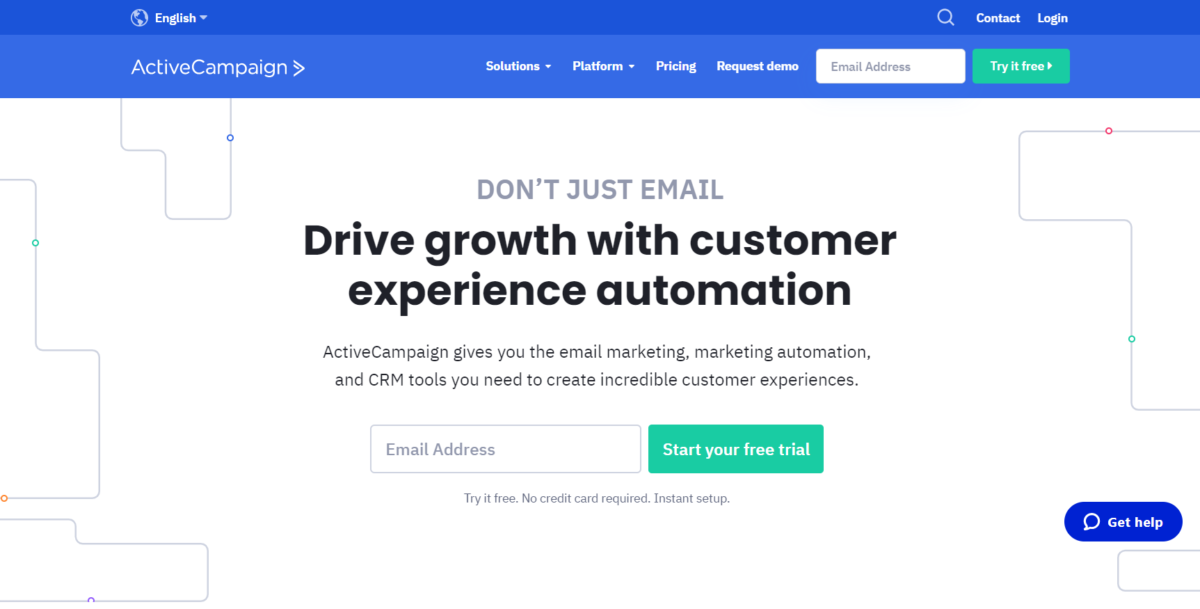
ActiveCampaign is one of the best email marketing software options available for email marketers. It combines email automation with multi-channel marketing and customer relationship management (CRM) software.
Pricing plans start at $9/month, billed annually.
2. Mailchimp
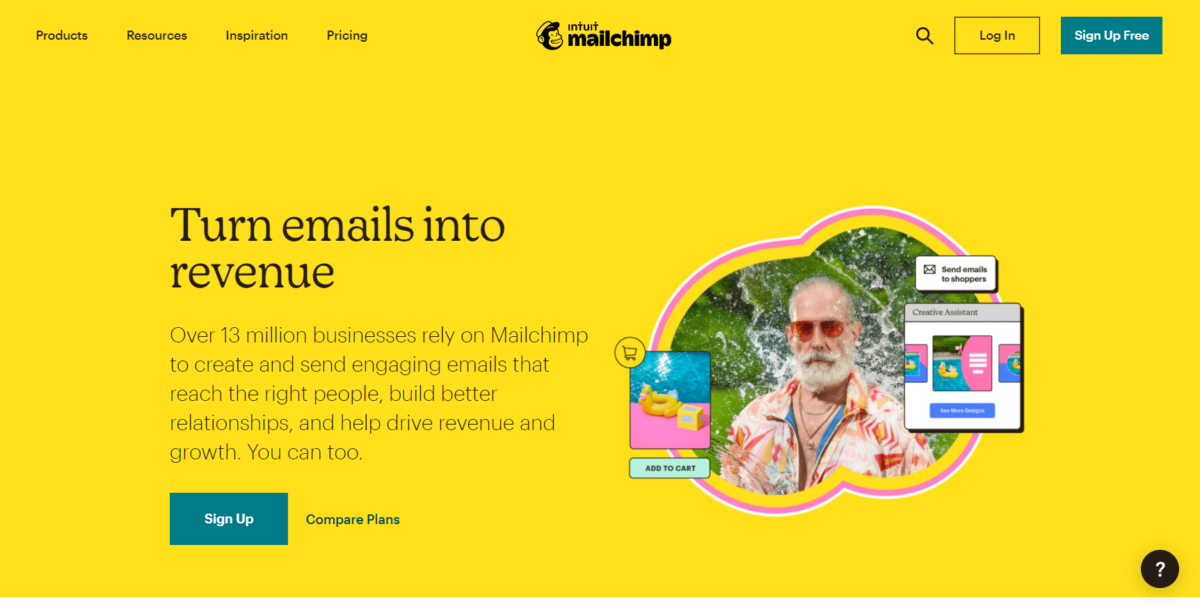
Mailchimp is a straightforward email marketing tool. It can send drip campaigns with dynamic content based on their website activity, cart abandonment, and more. There is a free plan available with limited lists but no automation features.
Mailchimp is a popular email platform because it has an intuitive interface that’s easy to use.
Pricing starts at $17/month.
3. Constant Contact

Constant Contact offers a fast and easy setup, making it an excellent option for beginners who need a simple user interface. You’ll need the more advanced plans that start at $45/month to take advantage of the email automation features. The base plan works well if you’re just sending regular email newsletters.
Your total price depends on the size of your contact list.
4. AWeber

AWeber is another email marketing platform that makes it easy to build connections to your audience with personalized customer experiences. It has a Follow Up feature that allows you to quickly bring new subscribers up to speed without bombarding their email boxes with a ton of past emails.
Pricing starts at $19/month.
5. Sendinblue

Sendinblue goes beyond email marketing to offer complete marketing automation with SMS messaging solutions. The free plan allows for unlimited contacts and up to 300 emails per day. Marketing automation workflows are available for up to 2,000 email subscribers.
Pricing starts at $25/month and is based on your monthly email volume. Upgrading to a paid plan removes the Sendinblue logo and daily sending limits.
6. ConvertKit

ConvertKit is an email marketing automation tool with an advanced CRM and sales tools built-in. If you need highly-targeted marketing campaigns, this is the way to go. This marketing automation tool lets you send any number of targeted autoresponders to your subscribers based on their interactions with your emails, using automation rules and smart segmentation.
Pricing starts at $25/month, billed annually. A monthly plan isn’t available at this time.
7. GetResponse

GetResponse is more than a standard email marketing tool. The autoresponder features a drag-and-drop email builder to design your emails quickly. The calendar integration gives you a quick overview of your email campaigns at a glance. There’s a free plan for up to 500 contacts.
Pricing starts at $19/month for up to 1,000 contacts. To save money, you can opt for annual billing for an 18% discount or bi-annual billing for a 30% discount.
8. MailerLite

MailerLite is an easy-to-use, full-featured email platform. You can design your newsletters using the drag and drop tool, rich text, or custom HTML to make this tool work for you no matter your experience or comfort level with coding.
You can use it to build landing pages, popups, and even a website, if you need to. It supports automation and various workflows to suit your needs.
The free plan supports up to 1,000 subscribers and 12,000 bulk emails a month. Paid plans start at $10/month and are billed based on your subscriber volume.
How do you know which tool is right for you? Think about the:
- Marketing automation features you need. If you need more advanced features, prepare to pay for them.
- Number of emails you’ll send every month (many plans allow for unlimited emails, but free plans have limits)
- Other platforms the email marketing tools integrate with
- Marketing channels you’ll use.
- Kind of advanced reporting features you need, and whether there’s native integration with Google Analytics or the analytics tool of your choice.
You can switch email marketing service providers fairly easily. You’ll export your subscribers from one platform and import them into the other. Then, change your email sign up forms so they go to the right provider.
You will, however, need to rebuild your automations and email templates in each system, so if you find one you like, try to stick with it.
Tools to Grow Your List
Once you have your list built and a landing page to collect subscribers, it’s time to start making that list as big as you can. The key, though, isn’t to get just anyone on the list.For the greatest chance of success, you’ll want targeted people interested in whatever you offer. That may mean slower growth, but engagement is what really matters. Your marketing efforts are wasted if you target the wrong people. Focus growth efforts on potential customers.
9. Optinmonster

Optinmonster is a robust tool designed to help you convert your website traffic. You can use it to create popups, scroll boxes, and gamified wheels. Based on your goals, you can set these tools up any number of ways – on specific pages, during exit intent, based on geolocation, etc.
To further segment your lists and audience, you can use Optinmonster with many of the email marketing tools we mentioned above.
Pricing starts at $14/month.
10. HubSpot

HubSpot is a top marketing automation platform. Not only can you use it for email marketing, but you can use it for sales, too. It streamlines your email marketing campaigns with a series of automated workflows. There’s a free plan available, with limits.
Pricing starts at $50/month, with a 10% discount for an annual plan. The plan includes 1,000 marketing contacts. A premium plan is available for enterprise customers.
11. ReferralCandy

ReferralCandy is a referral program software. It includes ecommerce integration with popular platforms including Shopify and BigCommerce, making it a great option for ecommerce brands.
You can use it alongside your email marketing tools to create separate campaigns for people who are part of your referral program.
Use ReferralCandy to offer a percentage or dollar discount off a member’s next purchase. You can also offer cash, or custom gifts, such as free products or free shipping.
Pricing is monthly plus a percentage of commission. It starts at $49/month. Commission rates vary based on sales volume. For instance, if you sell $2,000 a month with a 2% referral rate, you’ll pay $49/month plus a $2 commission. At $200K monthly sales, that commission goes to $155.
12. Rafflecopter

Rafflecopter is a giveaway tool that you can use to promote your product or service. Making users subscribe to your email list to enter the giveaway is a great way to grow your list while boosting brand awareness.
Pricing starts at $13/month, but if you want integration with your email marketing tool, you’ll need the Growth plan for $43/month.
13. ProTexting SMS Marketing

ProTexting is an SMS marketing automation tool that works with a variety of marketing automation tools and ecommerce platforms, including:
- Constant Contact
- Mailchimp
- Vertical Response
- Amazon Seller Central
- Shopify
- Google Calendar
- Zapier
Pricing starts at $49/month for 1,000 messaging credits. Read our ProTexting review to learn more.
14. Popup Smart

Popup Smart is a popup designer tool that requires no code or technical knowledge to use. You can use it to:
- Get more subscribers on your email list
- Promote products and special offers
- Collect form submissions
- Get feedback from website visitors or customers
- Make social sharing easier
- And more.
The free version limits you to a single popup on one website, with 5,000 pageviews every month.
Paid versions start at $24/month and include unlimited pop ups on unlimited websites. Each plan has monthly pageview limits.
15. Customer.io

Customer.io is a marketing automation software for messaging. Not just for email, you can use it to send text messages and push notifications to users, too.
It uses a drag-and-drop style interface for you to create visual representations of your messaging workflows. You can create separate workflows for people on your email list and for people who use your mobile app.
Pricing starts at a minimum of $150/month for up to 12,000 user profiles. Additional profiles are charged monthly. Discounts are available for annual plans.
Tools to Test Your Emails
When you first start your ecommerce business, you’ll have to use industry data to guide you. You can refine your marketing campaigns to suit your audience better as you collect data.
These tools help you test your emails to ensure you won’t end up in the spam folder, optimize delivery, etc.
16. Litmus
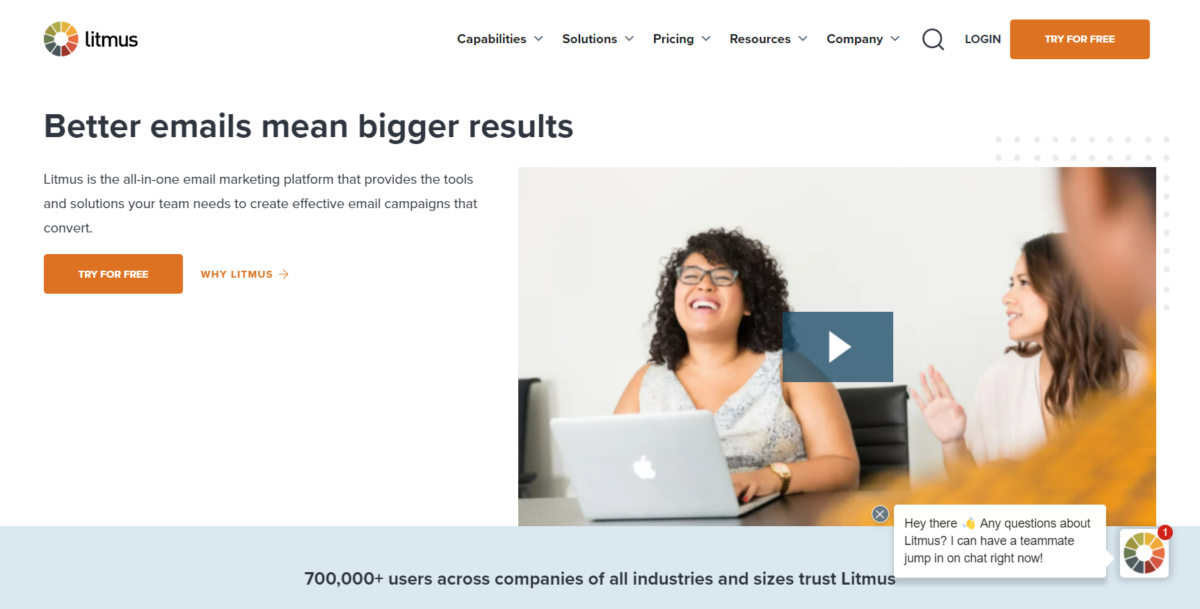
Litmus is an all-in-one tool that offers a suite of email marketing features. While you can use it for email marketing automation, we’ve included it here for its email testing features.
With it, you can see previews of your email messages and any potential issues or errors that could cause the emails to break. You can preview it in multiple email clients to make sure it works the way you intend.
The testing tool is compatible with a variety of desktop, mobile, and web email clients, including Outlook, AOL Mail, Gmail, and Yahoo.
Pricing starts at $99/month and includes 1,000 email previews a month. There’s a 20% discount available for annual plans.
17. Putsmail

Putsmail is a tool from Litmus that allows you to test your HTML emails before you send them. You can also use the Inliner tool to make sure your CSS elements are included inline. This approach helps to ensure consistent delivery across email platforms. Since each email client handles CSS differently, keeping your CSS inline helps to reduce the likelihood that the email will break.
The account is free and will keep track of past tests.
18. Stripo
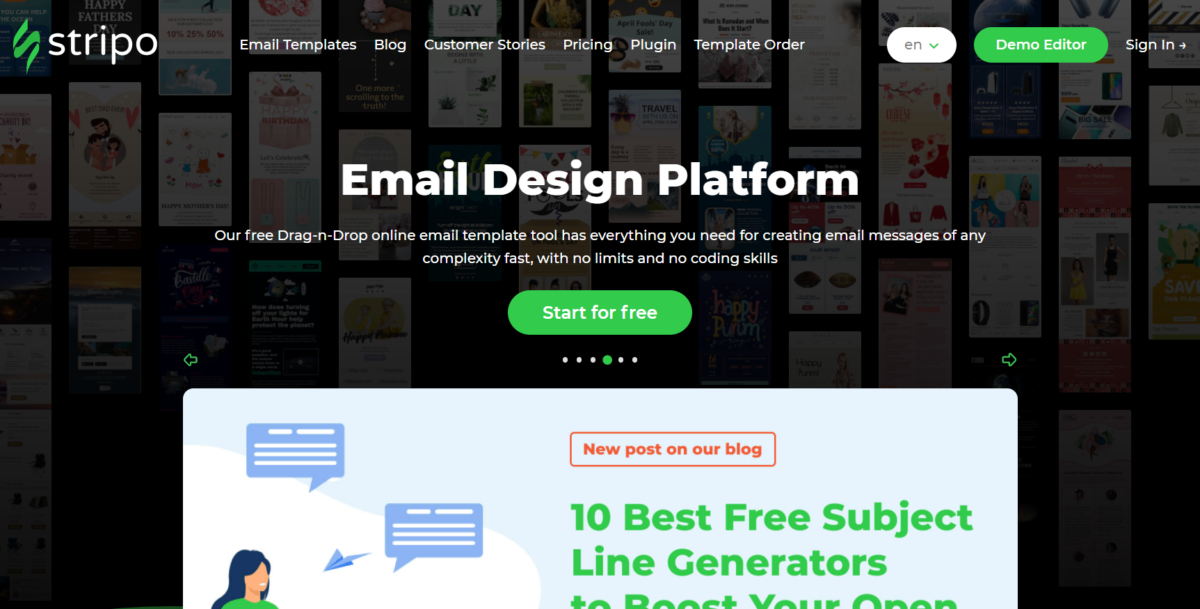
Stripo is an email template builder which allows you to build your email template file. You can use modules from their library to create your own, or start with any of theirs. They have a library of more than 900 fully customizable email templates.
You can use the drag and drop editor or the HTML and CSS code editor. You can export emails to the service provider or email editor of your choice. It also allows for AMP for email, custom fonts, and features an email annotations builder.
There is a free account that allows up to four exports a month. Paid plans start at $15/month. Pay annually and get two months free.
19.Sender Score from Validity

Sender Score is like a credit score but for email. It measures how healthy your email program is on a scale from 0 to 100.
The score comes from various metrics, including spam complaints, how many unknown users you’re emailing, whether you’re present on industry blacklists, and more.
If your score falls within 0-70, you need to take steps to improve your sender reputation. Between 70-80, you’re doing okay but still need to keep following industry best practices. At 80 or higher, you have an excellent sender reputation and may qualify for a certification that could get you preferential treatment with major email service providers.
The service is free to use, but you must have your IP address and monthly send volume.
20. Send Forensics

Send Forensics is a free email deliverability testing tool. When you complete the form, you’ll get a unique analysis address. All you have to do is send your emails to it and you’ll get real-time deliverability rates and testing.
You’ll get pre-emptive advice you can use to improve delivery rates and fix problems before they influence your sender reputation. You can also compare your performance with regional and industry benchmarks. You set alerts to keep an eye on your performance and reputation.
21. Cakemail

Cakemail is another all-in-one solution that offers a powerful email API service to send your emails through their SMTP service or web API.
It includes multivariate testing (aka split testing) tools to help you get better open rates. You can use it to test subject lines, calls to action, and more. These automated tests use artificial intelligence and machine learning.
You’ll be able to track which emails perform better to continually improve your marketing campaign management. Cakemail also has a “Spam Assassin” feature to ensure your emails don’t end up in subscribers’ spam folders.
The free plan allows you to manage a single list with up to 2,000 contacts, with 12,000 emails a month.
Pricing starts at $7/month.
Email Automation Examples
After you get your list set up, it’s time to make sure you’ve got the content you need in place. Take a look at these common emails with examples.
Welcome Emails

Welcome emails are those that welcome people to your email list, or your product or service.
These emails aim to personally introduce your business to the new subscriber without blasting a sales pitch. You’ll get better open rates when you add personal touches to the messaging. Generally, welcome messages have higher open and click-through rates than standard marketing emails.
Above, you can see the welcome email we send new subscribers who join the Ecommerce CEO mailing list. It gives an overview of what you can expect to get from us as a subscriber and invites you to reply to the message with questions and comments. We really do read and respond to all of them.
If you have the resources to open and read all your replies, you should let your new subscribers know that you will. But, if you don’t intend to monitor responses, don’t claim that you’ll read and respond to everything.
Onboarding Emails

Onboarding emails don’t just welcome someone to your list, but to your product as well. They are most common with software as a service (SaaS) providers, like the Shopify example you see above.
These emails provide login and account information with a call to action, such as “log in” or “get started.”
Transactional Emails

Transactional emails are those triggered by a specific action someone has taken on your site.
In the example above, we show a follow-up email from Target confirming the receipt of their order. It occurred after the customer made a purchase.
However, these aren’t limited to post-purchase emails. It could be when someone creates an account, and you provide their login information. It could be when someone signs up for a webinar, and you provide the access details.
Customer Anniversary/Birthday Celebrations

These emails are a great way to foster customer relationships and build loyalty. If you have the customer’s birthday, you can automatically send them a Happy Birthday email with a gift or special discount and a note that says they have a wonderful day.
Alternatively (or in addition to), you can send customers personalized messages on their original sign-up date every year. This is a short message to thank them for another year with your business and provides something to reward them.
These emails are a great way to re-engage inactive customers.
Above, we see Road Runner Sports provides $20 “cash” to spend on a pair of shoes as a thank you for being a loyal customer.
Re-Engagement Emails
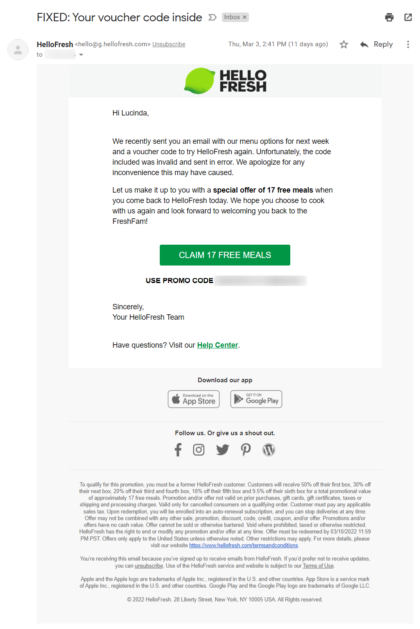
Re-engagement emails are designed to reach back out to inactive subscribers. These emails are meant to re-establish a connection with your audience. You can isolate these subscribers through engagement-based segmentation.
You can ask for feedback or, like the example above, send an offer to encourage them to return to your business.
Even if they end up unsubscribing from your list, it’s still good for you. Your engagement rates will go up.
Feedback Request Emails

With this message, you ask customers to provide feedback on your product or service. You can also ask them to leave a review for other website visitors to see. In the example above, BodyCandy asks the ecommerce customer to share their experience with a particular product from their last order.
These emails are also great to send after an event because you can use them to get opinions on how the attendees felt about the experience.
Feedback request emails help build customer loyalty because they help your customers see that you care about what they have to say. You can use the feedback for insights into customer sentiment. You may find ways to improve your product or service in the future.
Announcements

Announcement emails share news about your company, products, or service offerings. This particular example from Lume is announcing the scents being retired from the product lineup.
The intent is to let their customers know that if they enjoy these particular scents, they need to stock up before they are gone forever. Announcement emails can be used to increase sales, but don’t have to be.
Sales and Promotions
Sales and promotions are the emails you get from brands that give you the details of their most recent sales. The email below comes from Michael’s craft store. It’s the online version of the sales paper you can get at the front door when shopping in person.

You can build automated campaigns with any number of these kinds of emails. The best way to map out your automations is to follow the customer journey. As you go, consider your marketing funnel, and where contacts will end up throughout the process. If you have multiple sales funnels, you’ll need multiple automations.
After a customer signs up, send them the welcome email and any lead magnet you offered to encourage them to sign up.
If they purchased your SaaS product, send the onboarding sequence to help them get started. If they don’t make the purchase, you can trigger a different set of automated emails with a discount that encourages them to buy, or more educational material to convert them.
When you add one-off emails, you can send them to the appropriate segments of your email list so that your new subscribers who aren’t yet customers don’t get messaging specific to long-time customers.
FAQs
Supercharge Your Email Marketing with Automation
Invest in your email list if you really want to grow your business fast. Data from Litmus shows that for every $1 you spend on email marketing, you’ll earn an average of $36, meaning you’ll have a high return on investment. The key is to make sure you’re sending relevant messages.
You’ll spend a lot of time setting up the email automation software, but you’re running on autopilot once it’s done.
Your email marketing automation will run according to the triggers and timeline you set whenever you get a new subscriber. User behavior dictates which automations run and when.
With this list of email automation software options, you’ll have everything you need to build and grow your email list and can start sending emails in minutes.







